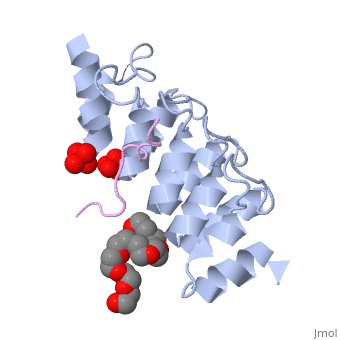3twr
From Proteopedia
(Difference between revisions)
| (5 intermediate revisions not shown.) | |||
| Line 1: | Line 1: | ||
| - | [[Image:3twr.png|left|200px]] | ||
| - | < | + | ==Crystal structure of ARC4 from human Tankyrase 2 in complex with peptide from human 3BP2== |
| - | + | <StructureSection load='3twr' size='340' side='right'caption='[[3twr]], [[Resolution|resolution]] 1.55Å' scene=''> | |
| - | + | == Structural highlights == | |
| - | + | <table><tr><td colspan='2'>[[3twr]] is a 8 chain structure with sequence from [https://en.wikipedia.org/wiki/Homo_sapiens Homo sapiens]. Full crystallographic information is available from [http://oca.weizmann.ac.il/oca-bin/ocashort?id=3TWR OCA]. For a <b>guided tour on the structure components</b> use [https://proteopedia.org/fgij/fg.htm?mol=3TWR FirstGlance]. <br> | |
| - | + | </td></tr><tr id='method'><td class="sblockLbl"><b>[[Empirical_models|Method:]]</b></td><td class="sblockDat" id="methodDat">X-ray diffraction, [[Resolution|Resolution]] 1.55Å</td></tr> | |
| - | - | + | <tr id='ligand'><td class="sblockLbl"><b>[[Ligand|Ligands:]]</b></td><td class="sblockDat" id="ligandDat"><scene name='pdbligand=PE8:3,6,9,12,15,18,21-HEPTAOXATRICOSANE-1,23-DIOL'>PE8</scene>, <scene name='pdbligand=SET:AMINOSERINE'>SET</scene>, <scene name='pdbligand=SO4:SULFATE+ION'>SO4</scene></td></tr> |
| - | + | <tr id='resources'><td class="sblockLbl"><b>Resources:</b></td><td class="sblockDat"><span class='plainlinks'>[https://proteopedia.org/fgij/fg.htm?mol=3twr FirstGlance], [http://oca.weizmann.ac.il/oca-bin/ocaids?id=3twr OCA], [https://pdbe.org/3twr PDBe], [https://www.rcsb.org/pdb/explore.do?structureId=3twr RCSB], [https://www.ebi.ac.uk/pdbsum/3twr PDBsum], [https://prosat.h-its.org/prosat/prosatexe?pdbcode=3twr ProSAT]</span></td></tr> | |
| + | </table> | ||
| + | == Disease == | ||
| + | [https://www.uniprot.org/uniprot/3BP2_HUMAN 3BP2_HUMAN] Defects in SH3BP2 are the cause of cherubism (CRBM) [MIM:[https://omim.org/entry/118400 118400]. CRBM is an autosomal dominant inherited syndrome characterized by excessive bone degradation of the upper and lower jaws, which often begins around three years of age. It is followed by development of fibrous tissue masses, which causes a characteristic facial swelling.<ref>PMID:11381256</ref> <ref>PMID:12900899</ref> <ref>PMID:14577811</ref> | ||
| + | == Function == | ||
| + | [https://www.uniprot.org/uniprot/3BP2_HUMAN 3BP2_HUMAN] Binds differentially to the SH3 domains of certain proteins of signal transduction pathways. Binds to phosphatidylinositols; linking the hemopoietic tyrosine kinase fes to the cytoplasmic membrane in a phosphorylation dependent mechanism. | ||
| + | <div style="background-color:#fffaf0;"> | ||
| + | == Publication Abstract from PubMed == | ||
| + | The poly(ADP-ribose)polymerases Tankyrase 1/2 (TNKS/TNKS2) catalyze the covalent linkage of ADP-ribose polymer chains onto target proteins, regulating their ubiquitylation, stability, and function. Dysregulation of substrate recognition by Tankyrases underlies the human disease cherubism. Tankyrases recruit specific motifs (often called RxxPDG "hexapeptides") in their substrates via an N-terminal region of ankyrin repeats. These ankyrin repeats form five domains termed ankyrin repeat clusters (ARCs), each predicted to bind substrate. Here we report crystal structures of a representative ARC of TNKS2 bound to targeting peptides from six substrates. Using a solution-based peptide library screen, we derive a rule-based consensus for Tankyrase substrates common to four functionally conserved ARCs. This 8-residue consensus allows us to rationalize all known Tankyrase substrates and explains the basis for cherubism-causing mutations in the Tankyrase substrate 3BP2. Structural and sequence information allows us to also predict and validate other Tankyrase targets, including Disc1, Striatin, Fat4, RAD54, BCR, and MERIT40. | ||
| - | + | Structural basis and sequence rules for substrate recognition by tankyrase explain the basis for cherubism disease.,Guettler S, Larose J, Petsalaki E, Gish G, Scotter A, Pawson T, Rottapel R, Sicheri F Cell. 2011 Dec 9;147(6):1340-54. PMID:22153077<ref>PMID:22153077</ref> | |
| + | From MEDLINE®/PubMed®, a database of the U.S. National Library of Medicine.<br> | ||
| + | </div> | ||
| + | <div class="pdbe-citations 3twr" style="background-color:#fffaf0;"></div> | ||
| - | + | ==See Also== | |
| - | + | *[[Poly(ADP-ribose) polymerase 3D structures|Poly(ADP-ribose) polymerase 3D structures]] | |
| - | + | == References == | |
| - | + | <references/> | |
| - | + | __TOC__ | |
| - | + | </StructureSection> | |
| - | == | + | |
| - | [[ | + | |
| - | + | ||
| - | == | + | |
| - | < | + | |
[[Category: Homo sapiens]] | [[Category: Homo sapiens]] | ||
| - | [[Category: | + | [[Category: Large Structures]] |
| - | [[Category: | + | [[Category: Guettler S]] |
| - | [[Category: | + | [[Category: Sicheri F]] |
| - | + | ||
| - | + | ||
| - | + | ||
Current revision
Crystal structure of ARC4 from human Tankyrase 2 in complex with peptide from human 3BP2
| |||||||||||

